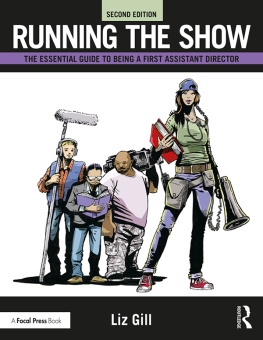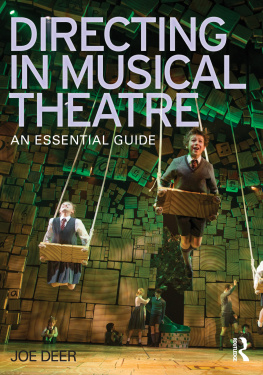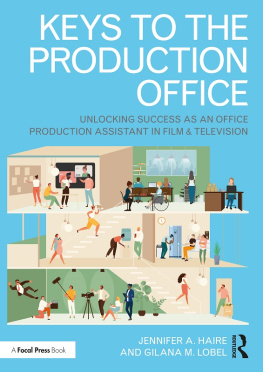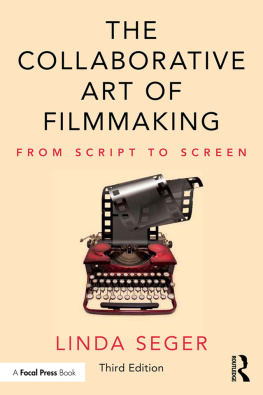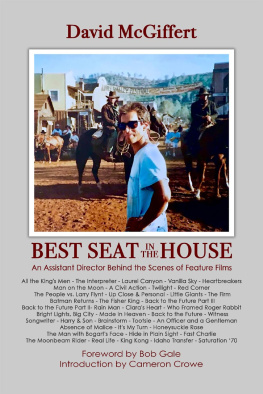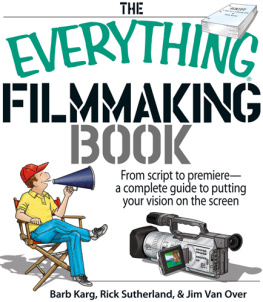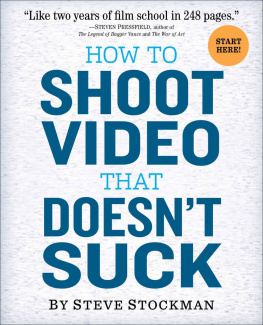Id like to offer my sincere and unlimited thanks to Breda Walsh, Elsie Walsh, Conor McCarthy, Annie Gill, Betsy Gill, Michael Gill, Neil Winterlich, Oorlagh George, Seamus McInerney, Bryan Thomas, Noelette Buckley, Tim Bird, Thomas Whelan and Elsie Lau at Entertainment Partners; Sahar Moridani at the DGA; Elizabeth Moseley at SAG; and Ken Segna at Starz Encore.
And especially Dennis McGonagle, Lauren Mattos and Anne McGee at Focal Press for green lighting, producing and distributing this book and to Sarah Pickles and Sheni Kruger for all their help with this second edition.
Special thanks to artist Stephen Daly for the cover image.
Appendix 1
SAG tier budget thresholds
$50K$200K: Ultra low-budget
$200K$625K: Modified low-budget
$625K$2.5 m: Low budget
$2.5 m$10.2 m: Basic agreement
These figures are intended only as a ballpark guideline they evolve constantly, so its important to check the SAG-AFTRA budget tiers online:
www.sagindie.org
More information is also available at: www.sag.org/productioncenter/theatrical/documents?quicktabs_6=1#quicktabs-6
Appendix 2
Filmmakers code of professional responsibility
Reprinted with the permission of FilmL.A., Inc.
Dear Neighbors: At FilmL.A., we work to create an environment where on-location filming is conducted with professionalism and courtesy. Our job is to coordinate permits for on-location filming in a way that minimizes the impact of film production on your neighborhood. Production companies are obligated to adhere to this Filmmakers Code of Professional Responsibility. If you find a production company is not complying with the provisions below, please call us at 213.977.8600, day or night.
Dear Filmmakers: You can count on FilmL.A. to apply our knowledge and expertise to help you film in local neighborhoods. Maintaining a positive working relationship with community members will help ensure continued access to the greatest variety of locations. As a guest in area neighborhoods, you are obligated to treat the public and the location with courtesy. The provisions in this code are a part of your permit.
- The production company must comply with the provisions of the film permit at all times.
- The Filmmakers Code of Professional Responsibility will be attached to every permit, and both must be shown to any member of the public that asks to see them.
- Productions arriving on-location in or near a residential neighborhood shall enter the area no earlier than the time stipulated on the permit.
- Moving or towing vehicles is prohibited without the express permission of the local municipality or the vehicle owner.
- Cast and crew must observe designated parking areas. Parking of cast and crew vehicles on public streets is prohibited unless authorized by the film permit.
- Parking on both sides of public streets is prohibited unless specifically authorized by the film permit.
- Production vehicles may not block driveways without the express permission of the local municipality or the driveway owner.
- Noise levels should be kept as low as possible. Generators and vehicles producing exhaust should be placed as far as practical from residential buildings. Do not let engines run unnecessarily.
- Cast and crew are to remain on or near the area that has been permitted. Do not trespass onto neighboring residential or commercial property.
- Designated smoking areas must be observed, and cigarettes must always be extinguished in butt cans.
- Removing, trimming and/or cutting of vegetation or trees is prohibited unless approved by the owner, or in the case of parkway trees, the local municipality and property owner.
- If not specified in the permit, an area for meal service and consumption must be designated. All trash must be disposed of properly upon completion of the meal.
- All members of the production company should wear clothing that conforms to good taste and common sense. Shoes and shirts must be worn at all times.
- Crew members should not display signs, posters or pictures that do not reflect common sense and good taste.
- Cast and crew shall refrain from using lewd or offensive language within earshot of the general public.
- Cast and crew must not bring guests or pets to the location, unless expressly authorized by the permit.
- All catering, crafts service, construction, strike and personal trash must be removed from the location.
- All signs removed (or erected) for filming purposes must be replaced (or removed) after use of the location unless otherwise stipulated by the location agreement or permit.
- When departing the location, all signs posted to direct production company personnel to the location must be removed.
- When production ID passes are issued, every crew member must wear the pass while on-location.
Appendix 3
Some filmster jokes
The Life of a Lightbulb
How many X does it take to change a lightbulb?
DP: One. No, two. Maybe three. How many do we have on the truck?
Director: I asked for a chandelier.
PM: Does it have to be a lightbulb?
Electrician: Three two to change the bulb and one to fill in the timesheet.
Grip: Two one to change the bulb and one to talk about how they did it on the last job.
Actors: None, my character wouldnt do that.
First AD: One, it looks good, lets shoot it!
Teamsters
Why is a horse in the Teamsters logo?
Theyre the only two animals that can sleep standing up.
How do you know a Teamsters dead?
He drops his donut.
What do you call a Teamster in a suit?
The defendant.
How can you spot the Teamsters kids in the playground?
Theyre the ones sitting around watching the other kids play.
Whats the Teamsters definition of foreplay?
Back it up, back it up

Running the show: an AD community
Sample schedules, call sheets, production reports; a hub for ADs and other filmmakers at www.runningtheshowbook.com and on our Facebook page
Training
DGA trainee scheme: www.trainingplan.org/
http://pabootcamp.com/
www.filmskills.com/
Job search
www.media-match.com/
www.Backstage.com
www.hollywoodreporter.com (movies in pre-production section, requires registration)
www.TheFutonCritic.com
www.FilmStaff.com
www.ProductionHub.com
www.EntertainmentJobs.com
www.Mandy.com
www.infolist.com/
All state film commissions have websites that list what productions are coming to town and when.
Child labor
www.sag.org (US)
www.childreninfilm.com/Rules-State-Labor-Info.aspx (US)
http://wwwdirect.gov.uk/en/Parents/ParentsRights/DG_4002945 (UK)
Crew work practices
www.callacrew.co.za/workingconditions.php (South Africa)
DGA www.dga.org (US)
IATSE www.iatse-intl.org/home.html
PACT www.pact.co.uk (UK)
www.screenproducersireland.com (Ireland)
General code of safe practices for production
www.csatf.org/bulletintro.shtml
Filmmakers Code of Professional Responsibility: www.filmla.com/neighborhood_filming.php
Filmmakers community
Filmmakers Alliance: www.filmmakersalliance.org/Home.html
On-Set Entertainment: www.pajuice.com
Ready, Set, Recycle: http://readysetrecycle.com (Greening the Entertainment Industry)
Go for Filming: www.goforfilming.com/locations/advanced-search/ (Locations search website)

